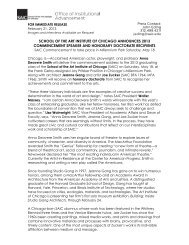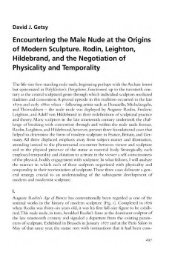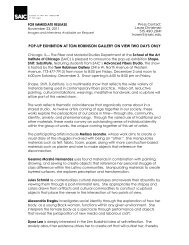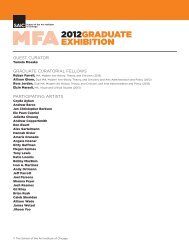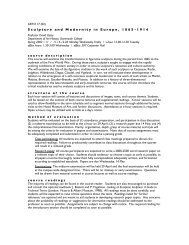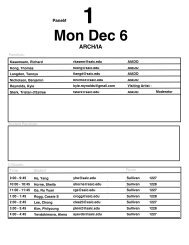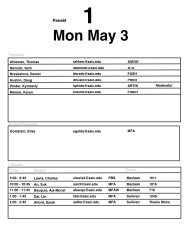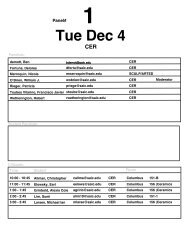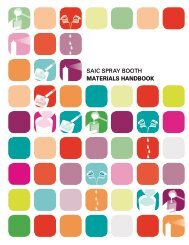i. institutional support and commitment to continuous improvement
i. institutional support and commitment to continuous improvement
i. institutional support and commitment to continuous improvement
You also want an ePaper? Increase the reach of your titles
YUMPU automatically turns print PDFs into web optimized ePapers that Google loves.
Course Number & Title:<br />
ARCH & INARC 6222 Sustaining Practice Economies<br />
(3)<br />
Course Description:<br />
The course provides critical, in-depth insight in<strong>to</strong> the<br />
Profession of Architecture by addressing, head-on,<br />
the legal <strong>and</strong> ethical ramifications of professional<br />
practice. Each major phase of design <strong>and</strong> construc-<br />
tion is tackled through the lens of the Architect’s<br />
role <strong>and</strong> his/her responsibility <strong>to</strong> the Client, the<br />
Community <strong>and</strong> the health & safety of the Public.<br />
Course Goals & Objectives:<br />
1) Design practice: The class is a forum for the ex-<br />
amination of contemporary models of architecture<br />
practice. Generally, the course prepares students<br />
<strong>to</strong> anticipate <strong>and</strong> navigate the complexity of es-<br />
tablishing a nimble <strong>and</strong> purposeful<br />
design practice.<br />
2) Design practice: The logistics of practice are<br />
broken down, unveiling the strategies <strong>and</strong> pro-<br />
cesses of operating a business, pursuing com-<br />
missions, negotiating contracts <strong>and</strong> managing a<br />
project during design & construction. In <strong>support</strong><br />
of this, the class visits a wide array of Architecture<br />
Offices ranging in scale, professional structure <strong>and</strong><br />
design approach.<br />
Student Performance Criterion:<br />
1) Best exemplifies the following criteria<br />
a) C.4. Project management (underst<strong>and</strong>ing)<br />
b) C.5. Practice management (underst<strong>and</strong>ing)<br />
c) C.6. Leadership (underst<strong>and</strong>ing)<br />
d) C.7. Legal responsibility (underst<strong>and</strong>ing)<br />
e) C.8. Ethics (underst<strong>and</strong>ing)<br />
2) Additional criteria<br />
a) B.7. Financial issues (underst<strong>and</strong>ing)<br />
b) C.3. Client role<br />
Topical Outline:<br />
1) Design practice: Provides insight in<strong>to</strong> the legal<br />
<strong>and</strong> ethical ramifications of agreements <strong>and</strong> con-<br />
tracts with clients for<br />
professional architectural services, <strong>and</strong> responsi-<br />
bilities <strong>and</strong> liabilities during construction observa-<br />
tion; 40% of class.<br />
2) Provides insight in<strong>to</strong> the financial manage-<br />
ment of offices that offer professional design <strong>and</strong><br />
architecture services, <strong>and</strong> other kinds of design<br />
businesses; 40% of class.<br />
3) Provides information on the fundamental skills<br />
required <strong>to</strong> pursue a career in the Architecture<br />
<strong>and</strong> Design Professions. These include workshops<br />
on resumes, CV’s, portfolios, interviewing tech-<br />
niques as well as Accreditation processes such as<br />
the Intern Development Program (IDP), The Ar-<br />
chitect Registration Examination (ARE) <strong>and</strong> LEED<br />
Certification; 20% of class.<br />
Prerequisites:<br />
All required fifth semester courses.<br />
Textbooks/Learning Resources:<br />
Various articles <strong>and</strong> essays including:<br />
• AIA, “2007 Code of Ethics <strong>and</strong> Professional<br />
Conduct”<br />
• AIA, “Document A201-1997: General Condi-<br />
tions of the Contract for Construction.”<br />
• Cobb, Henry, “Ethics <strong>and</strong> Architecture” in<br />
Harvard Architecture Review 8<br />
• NCARB, “Architectural Organizations <strong>and</strong><br />
the Practice of Architecture in the United States”<br />
• Sapers, Carl, “Ethical Boundaries” (1996)<br />
• Thomsen, Charles, “Project Delivery Strat-<br />
egy”<br />
Offered (semester <strong>and</strong> year):<br />
• Semester: SPRING<br />
• Year: THREE<br />
Faculty assigned:<br />
• 2009-2010 academic year:<br />
185 | Spring 2011<br />
Newman, Michael (P/T), Tebben, Paul (P/T<br />
• 2010-2011 academic year:<br />
Newman, Michael (P/T), Tebben, Paul (P/T)<br />
IV. Supplemental Information<br />
Supplemental Information<br />
SECTION IV



